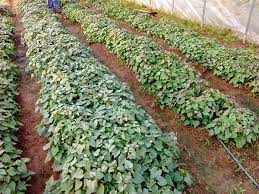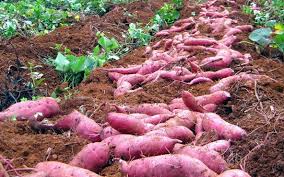

Sweet potatoes are easy to plant, need little looking after and deliver high yields. They are usually grown in sandy soil, which makes them easier to dig up. But they also do well in most soils, even heavy clay.
Production Areas
Currently, sweet potato is cultivated in more than 100 countries, mostly throughout tropical and subtropical Asia. In South Africa Limpopo, Mpumalanga, KZN and Western Cape provinces are the major production areas.
Cultivars
There are two broad categories of sweet potato:
1. The staple type with white flesh and white or purple skin has a high starch and dry-maltier content.
2. The desert type with orange flesh and orange skin with a high sugar and beta-carotene content.
Soil Requirements
A well-drained sandy loam is preferred and heavy clay soils should be avoided as they can retard root development, resulting in growth cracks and poor root shape. Lighter soils are more easily washed from the roots at harvest time. Wet season green manure cropping with sterile forage sorghum is recommended and should be thoroughly incorporated and decomposed by planting time.
Planting Period
Planting time of sweet potatoes is mainly determined by the climate of a location. Sweet potato plants are damaged by light frost and the plants required high temperatures for a period of 4 to 5 months to yield well. In areas with mild frost , mid-November to mid – December is the best time to plant, and usually the crops get ready for harvest from April to May. Cold spells during winter can be a risk, depending on the climate of the specific area. In very hot areas, planting should be avoided from November to middle February as storage root formation is reduced by high temperatures.
Spacing
Optimum plant density depends on the cultivar, but is usually around 40 000 plants per hectare. Rows may vary from 1 to 1,25m apart; in-row spacing it is usually 25 to 30cm.
Irrigation
Requirements for water vary with soil type but can be generally estimated as 18 to 20mm per week early in the season, 40 to 45mm per week during the middle part of the season when storage roots are enlarging rapidly and a reduction to about 20mm late in the season. Excessive moisture early in the season delays storage root development and enlargement; late in the season, it induces cracking and for rotting of roots.
Health Benefits:
* Rich in complex carbohydrates, fibre, Vitamins A,C, and B6.
* Pink yellow and green varieties are high in carotene, the precursor of vitamin A.
* Dark orange flesh have more beta carotene than those with light colored flesh.
* Beneficial food for diabetes because it stabilize blood sugar levels.
NEED TO KNOW MORE OR NEED A PROFESSIONAL FARMING BUSINESS PLAN CONTACT US NOW – (27)84 583 3143 OR EMAIL – money@global.co.za


